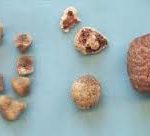 Can you imagine a ‘lost’ gallstone causing infection in the abdomen, a decade after gallbladder removal surgery? Well…it’s not a common occurrence, but it happens! I’ve seen 2 such cases so far in my career.
Can you imagine a ‘lost’ gallstone causing infection in the abdomen, a decade after gallbladder removal surgery? Well…it’s not a common occurrence, but it happens! I’ve seen 2 such cases so far in my career.
The one case I remember clearly, is of an elderly patient who presented to the hospital with right sided pain present for several weeks, then fever with chills for several days. Studies done showed that there was an abscess right next to the liver. At the time we thought it was an incidental liver abscess.
The abscess was drained, via a tube placed through the skin, and the patient was treated with antibiotics for 6 weeks.
Unfortunately, the abscess came back about 2 months after the antibiotics were stopped, and the patient came back to the hospital with the same right sided pain and fever. The abscess was drained again, and the same bacteria was cultured. This time, antibiotics were given for 3 months.
This seemed to have done the trick because I didn’t hear from the patient again, until…3 years later!
The patient once again developed pain to the right side with fever, and so made the trip to the hospital, realizing that it was probably the liver abscess again. Indeed it was the abscess, but this time it extended to the ribcage.
Because this was a recurring problem over some years, we realized that the patient’s only hope for complete eradication, was actual surgery to go in, and clean out all the pus and infected material harboring the germ over these 3+ years.
Surgery was done and the pus was cleaned out. But, lo and behold, there were 2 gallstones sitting in the pus! The same bacteria as 3 years earlier, was cultured once again. How could this be?! The patient had gallbladder removal surgery 10 years ago!
Antibiotics were given for a few weeks following surgery, and the patient was on the way to a complete recovery.
How can a ‘lost’ gallstone cause infection years after gallbladder surgery?
In the earlier days, the gall bladder was removed with a big surgical cut in the abdomen and it was easy to get everything out in one piece. However in recent decades, we have had laparoscopic, or ‘keyhole’ surgery. In this minimally invasive surgery, small openings are made into the abdomen where ports for surgical instruments are inserted, to perform the surgery. These ‘keyhole’ surgeries result in smaller surgical scars and a much shorter recovery time.
However, with surgery through ‘keyholes,’ because there is less space for maneuvering, more dexterity is required. Sometimes, in grabbing the gallbladder for removal, it may get punctured, and gallstones may spill out, along with some bile fluid. If this happens, the surgeon usually tries to quickly remove any visible gallstones, and wash and suction out spilled bile fluid, in case it was infected. However, sometimes, a gallstone or two (or more) may not be seen, and essentially get ‘lost’ somewhere in the abdomen.
If ‘lost’ gallstones have bacteria within them, the bacteria can brew slowly over time. The body fights back and the bacteria and pus are walled off and well contained as an abscess. These abscesses tend to present within months after gallbladder removal surgery. However there are cases reported where the abscess presented up to 15 years post surgery. If the load of bacteria in the gallstone(s) was low and/or the affected person had a strong immune system, that could result in the abscess not being apparent until years later.
To decrease the chance of spillage of the contents of the gallbladder into the abdomen, oftentimes, bags are used to enclose and contain the gallbladder and it’s contents while it is being removed. If it ruptures, the contents spill into, and are contained in the bag, which is removed through one of the keyholes. I can imagine however, that these bags may not be available in developing countries. (But then again, some developing countries, and probably most undeveloped countries, probably don’t have widespread access to minimally invasive surgery in the first place.)
Fortunately, this complication ‘lost’ gallstones causing abscesses, is rare, so generally one does not have to worry about this happening to them.
The moral of this story is, if an abscess keeps coming back at the same spot, especially if it is being caused by the very same germ, there is a good chance that there is some foreign material in the area. The foreign material serves as a nidus for the infection. Thorough surgical exploration is often required to eradicate the infection once and for all.
 Ken Switzer says
Ken Switzer says
December 16, 2016 at 3:49 amI had the same thing happen to me. I had the injection 1 1/2 years later after gallblatter removal. The doctors could not find the stones or anything else that caused the pain and jaundice. I was out of state and had to catch a flight back home or loose the ticket.
After I got back home I took a Hot bath with a cup of baking soap and about a cup of 35% peroxide. I did that 2 times and lost the jaundice in 2 days that the doctors said I would have for 3 -4 months.. this flushed all of the toxins out of my body.
I now do this every time a cold tries to get started and get immediatelt relief.
 infectiousmd says
infectiousmd says
December 16, 2016 at 1:45 pmVery interesting; glad you got better. Thanks for reading The Infectious Doctor blog!